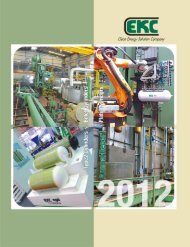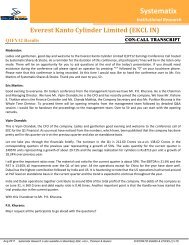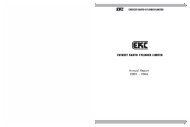Download PDF - Everest Kanto Cylinder Ltd.
Download PDF - Everest Kanto Cylinder Ltd.
Download PDF - Everest Kanto Cylinder Ltd.
You also want an ePaper? Increase the reach of your titles
YUMPU automatically turns print PDFs into web optimized ePapers that Google loves.
EVEREST KANTO CYLINDER LIMITED<br />
v. Accounting of foreign branch (integral foreign<br />
operation):<br />
- Monetary assets and liabilities are converted<br />
at the appropriate rate of exchange<br />
prevailing on the Balance Sheet date;<br />
- Fixed assets and depreciation thereon are<br />
converted at the exchange rates prevailing<br />
on the date of the transaction.<br />
- Revenue items are converted at the rate<br />
prevailing on date of the transaction.<br />
F. Fixed Assets and Depreciation / Amortisation:<br />
a. Fixed Assets:<br />
Fixed Assets are carried at cost of acquisition /<br />
construction or at revalued amounts less accumulated<br />
depreciation and amortisation. Cost of acquisition<br />
includes taxes / duties (net of credits availed) and other<br />
attributable costs for bringing assets to the condition<br />
required for their intended use.<br />
b. Depreciation / Amortisation:<br />
i. Cost of Leasehold Land is amortised over the<br />
period of the lease;<br />
ii. Intangible assets are amortized on a Straight Line<br />
basis over the estimated useful life of the<br />
respective asset, not exceeding a period of ten<br />
years;<br />
iii. Depreciation on other assets is provided as per<br />
the Straight Line method at the rates permissible<br />
under applicable local laws;<br />
iv. Cost of Customised software capitalized is<br />
amortised over a period of five years.<br />
G. Investments:<br />
Investments are classified into Current and Long-term<br />
Investments. Current Investments are stated at lower of cost<br />
and fair value. Long-term Investments are stated at cost. A<br />
provision for diminution is made to recognise a decline other<br />
than temporary in the value of Long-term Investments.<br />
H. Inventory Valuation:<br />
a. The inventories resulting from intra-group transactions<br />
are stated at cost after deducting unrealised profit on<br />
such transactions.<br />
b. Goods in transit are stated 'at cost'.<br />
c. Other inventories are stated 'at cost or net realisable<br />
value', whichever is lower.<br />
d. Cost comprises all costs incurred in bringing the<br />
inventories to their present location and condition. Cost<br />
formulae used are either 'average cost', 'first-in-firstout'<br />
or ‘specific identification’ as applicable.<br />
I. Taxation:<br />
Income-tax expense comprises Current tax, Fringe Benefit<br />
Tax and Deferred tax charge or credit.<br />
a. Provision for current tax is made on the assessable<br />
income at the tax rate applicable to the relevant<br />
assessment year.<br />
b. Provision for Fringe Benefit Tax is made on the fringe<br />
benefits provided / deemed to have been provided<br />
during the year at the rates and the values applicable<br />
to the relevant assessment year.<br />
c. Deferred Tax is recognized on timing difference<br />
between taxable income and accounting income that<br />
originated in one period and are capable of reversal in<br />
one or more subsequent period(s). The Deferred tax<br />
Asset and Deferred tax Liability is calculated by<br />
applying tax rate and tax laws that have been enacted<br />
or substantively enacted by the Balance Sheet date.<br />
Deferred tax Assets arising on account of brought<br />
forward losses and unabsorbed depreciation under tax<br />
laws are recognised only if there is a virtual certainty of<br />
its realisation supported by convincing evidence.<br />
Deferred tax assets on account of other timing<br />
differences are recognised only to the extent there is a<br />
reasonable certainty of its realisation. At each Balance<br />
Sheet date the carrying amount of deferred tax assets<br />
are reviewed to reassure realisation.<br />
J. Borrowing Costs:<br />
Interest and other borrowing costs attributable to acquisition /<br />
construction of qualifying assets are capitalised as part of the cost<br />
of such assets upto the date the assets are ready for their intended<br />
use. Other borrowing costs are charged as expense in the year in<br />
which these are incurred.<br />
K. Impairment of Assets:<br />
The carrying amounts of assets are reviewed at each<br />
Balance Sheet date to assess whether there is any indication<br />
that an individual asset / group of assets (constituting a Cash<br />
Generating Unit) may be impaired. If there is any indication<br />
of impairment based on internal / external factors i.e. when<br />
the carrying amount of the assets exceed the recoverable<br />
amount an impairment loss is charged to the Profit and Loss<br />
Account in the year in which an asset is identified as impaired.<br />
An impairment loss recognized in prior accounting periods<br />
is reversed or reduced if there has been a favourable change<br />
in the estimate of the recoverable amount.<br />
L. Government Grants:<br />
Government grants received to meet the costs of specific<br />
fixed assets, are recognised as a reduction in the cost of the<br />
respective asset. Revenue grants are recognised in the Profit<br />
and Loss Account on a systematic basis so as to match the<br />
related costs.<br />
M. Expenditure During Construction and Expenditure on New<br />
Projects:<br />
In case of new projects and in case of substantial<br />
modernization / expansion at existing units of the Company,<br />
expenditure incurred prior to commencement of commercial<br />
production is capitalised.<br />
Annual Report 2010-11 Schedules forming part of Consolidated Financial Statements<br />
65







